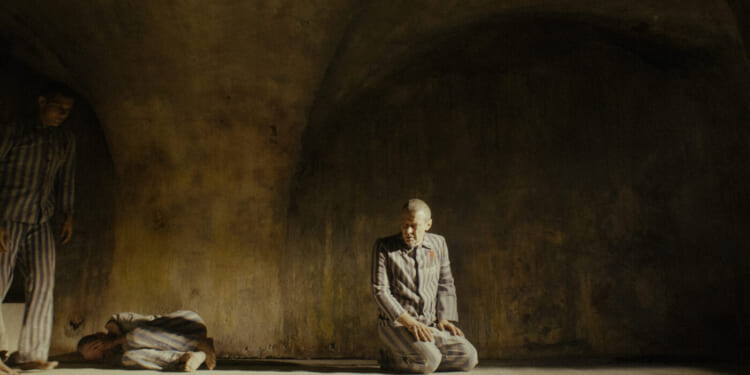There are films you watch, and when the credits roll, you simply resume where you left off—unchanged, untouched. Then there are rare films that do something altogether different: they arrest you, stretch you, leave you quietly unsettled, pressing on wounds you thought were long buried. Triumph of the Heart, Anthony D’Ambrosio’s searing new cinematic meditation on St. Maximilian Kolbe, belongs to the latter. Released in theaters on September 12, 2025, this 90-minute feature immerses viewers in the saint’s final days at Auschwitz, transforming a historical tragedy into a profound invitation to Catholic sanctity.
Unlike the heartfelt Evangelical movies of relatively recent history, where earnest sermons were set in dramatic form and everything tied up neatly in the end, this film resists both cheap catharsis and the shallow gloss of “religious entertainment.” Its gift lies in the very opposite—in a raw imperfection that mirrors life itself. It is at once gritty and ugly, and yet, precisely in that grit, it radiates something of surpassing beauty. Drawing from D’Ambrosio’s own journey through personal despair—a “starvation bunker” of the mind where he battled insomnia, loss, and wavering faith—the film echoes the director’s rediscovery of hope through Kolbe’s intercession, making it a testament to the Catholic truth that suffering, when united to Christ, becomes redemptive.
Art as Tapestry
The film’s great strength is its attentiveness to the craft of moviemaking itself. There is a visual poetry here, a cinematography that lingers, lighting that casts every shadow with purpose, pacing that draws the past and present into a single tapestry. We are not offered hagiography or distant moralizing. Instead, we are led into Auschwitz—into Block 11’s starvation bunker, where ten men were condemned to die slowly after a prisoner’s escape.
Kolbe, portrayed with quiet intensity by Marcin Kwaśny, steps forward in a pivotal scene to volunteer his life for Franciszek Gajowniczek, a fellow inmate and father of a family, declaring simply, “I am a Catholic priest.” This act of self-gift, rooted in Kolbe’s lifelong devotion to the Immaculate Virgin Mary, unfolds not as an isolated heroism but as a priestly ministry that turns the bunker into an underground chapel.
Kwaśny’s performance captures Kolbe’s frailty and fortitude with authenticity: his emaciated frame, his gentle encouragement of the nine other men through whispered prayers, rosaries, and hymns like “Salve Regina,” even as dehydration and hunger claim lives one by one.
Supporting actors, including Christopher Sherwood as one of the condemned, bring grounded humanity to their roles—men like the defiant Bruno Borgowiec or the despairing others who find flickers of solidarity in Kolbe’s presence. D’Ambrosio’s direction, informed by his pilgrimage to Poland and immersion in Franciscan archives, ensures these moments feel visceral: the dim light filtering through cracks, the echoing coughs, the gradual shift from chaos to a fragile communion. After 14 days, when only four remain—including Kolbe—they are lethally injected with carbolic acid, but not before Kolbe’s final blessing elevates their suffering to an imitation of Christ’s Passion.
Film as Retreat
This is not mere entertainment. It is a “retreat” in the truest Catholic sense—a surrender of the superficial to behold the profound, much like a silent Ignatian exercise or a pilgrimage to a martyr’s shrine. It stretches, strains, and wounds, drawing us into depths we might avoid, yet offering the grace of encounter with the Paschal Mystery.
The film does not flinch from human sin or from the darkness lodged in every heart. It explores how that darkness infects relationships, how the choices of one man ripple into the pain of another, how the Nazi machinery of death thrived on the small compromises of many. And yet, within this harrowing landscape, St. Maximilian Kolbe emerges—not as a flawless icon, but as a man whose radical act of love, reverberating through his final desolate days, revealed what we are all made for: the total self-gift that echoes Christ’s words, “No one has greater love than this, to lay down one’s life for one’s friends” (Jn. 15:13).
The genius of the film is that it makes Kolbe’s martyrdom not only his story but ours. The pulse running through the bunker is the same unseen heartbeat running through our own lives, leading us—if we dare to follow—toward truth, goodness, beauty, and the God who animates them all. As the Catechism reminds us, “Christ died for all men,” offering each of us participation in His Paschal mystery (CCC 1260), a theme D’Ambrosio weaves subtly through flashbacks to Kolbe’s Marian consecration and priestly zeal.
Music, in particular, serves as one of the film’s deepest metaphors. The score is not background but participant, reaching into the soul, summoning resonance from places words cannot touch. It is no accident that tradition holds music as the work entrusted to the highest angel before his fall. That angel, unwilling to serve, could not bear to see the lowly exalted in the Incarnation. And yet in this film, music itself becomes the battleground where despair wrestles with hope, where cacophony yields to a fragile but real chorus of faith. The condemned men, each with their brokenness, form by Kolbe’s presence a kind of holy chorus, rising in defiance of the silence of Auschwitz, rising toward eternity—much like the Church’s liturgy, where song unites the faithful in praise amid worldly trials.
The effect is symphonic: moments of discord giving way to harmony, silence giving way to song, inviting viewers to reflect on their own call to servant leadership, where “the greatest among you must be your servant” (Mt. 23:11; CCC 876).
Why We Must See It
Triumph of the Heart is difficult to watch. But that difficulty is its grace. It is not designed to spoon-feed or distract; it is designed to awaken. The audience is not entertained so much as initiated—invited into an encounter that costs something, much like the sacraments that demand our full participation. By small acts of acquiescence, by allowing ourselves to be pierced, we find ourselves in the company of Kolbe and his fellow prisoners, confronted with the same God who sustained them in their starvation. For Catholics, this resonates deeply with the Assumption of Mary (CCC 966), whom Kolbe loved as the path to detachment from earthly riches (CCC 2544) and total surrender to divine will.
In the end, the film accomplishes what the best retreats do: it unsettles, it convicts, it draws forth hidden parts of the heart. And in so doing, it awakens us to the reality that sanctity is not an abstraction but a possibility—for Kolbe, for the men around him, and for us. As D’Ambrosio himself experienced, Kolbe’s story offers healing, a “balm and compass” for our wounds, pointing to the Jubilee of Hope where suffering is redeemed in Christ’s eternal embrace.
Triumph of the Heart is more than a film. It is a symphony of sacrifice, an icon in motion, a reminder that the brightest faith is forged in the darkest night. To enter its story is to risk being changed, to risk discovering that we, too, are made for the same blazing love that compelled Kolbe to give his life—and to invite that love into our families, parishes, and world.
Image from www.triumphoftheheart.com











